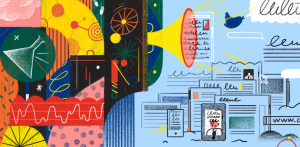How society interacts and receives information, including science-related news, has grown immensely over the years. From newspapers, radio, TV, to the internet and social media, everything is at your fingertips. However, these methods of communication still have limitations in reaching everyone. Researchers Nik Sawe, Chris Chafe, and Jeffrey Treviño at Stanford University understand this gap in communication and have identified a solution. Their study was done in 2020 in hopes to improve science communication, but it also holds promising aspects that can change how society communicates overall.

Illustration: GIZEM VURAL
Data sonification (DS) is a method that presents scientific data as sound. The researchers at Stanford have determined that DS in science communication can overcome complexity barriers, attract non-experts, and outreach to the disabled.
We suggest that a change in modality, from graphical representations to auditory ones using a process called data sonification, can reduce these barriers by creating an alternate way to engage with complex scientific data.
Overcoming Complexity
A 2019 report on public knowledge about science discovered that people avoid STEM-related material because it is “too hard” to understand. The Stanford researchers knew this and pointed to DS as a means to overcome this perception. By providing visual and auditory sources in scientific data, learning and engagement in individuals increases. Below is an example of combining visual and audio to text message data by Jack Jamieson and Jeffrey Boase

Public Engagement
Everyone loves listening to music, so why not incorporate it with scientific data to make it enjoyable? Music will not only enhance the listener’s experience with the data but also increases their ability to comprehend it. In addition, there are many online programs and applications that allow the public to turn their own data into music. This opens up opportunities for non-experts to collaborate with scientists in transforming numerical data into sound. Below is a sonification made by the Stanford researchers from data on the effects of climate change on the Alaskan yellow cedar tree.
http://stanford.edu/~sawe/alaskanyellowcedarsonification.wav
Outreach
In Canada, 1.5 million people are known to suffer from vision loss. With most scientific data represented graphically, it is difficult for the visually impaired to understand science and contribute to scientific discussions. For that reason, DS will make data accessible and understandable benefiting those who suffer from visual impairments and lower their risk of being fed wrong information. Below is a perfect example of data sonification by Haixia Zhao, Catherine Plaisant, and Ben Shneiderman tailored to those with vision problems.

Data sonification presents a promising solution in overcoming the barriers of science communication and potentially improve communication as a whole. To effectively implement it, however, science communicators must recognize the need for DS and understand its benefits. Overall, science has made big breaks in communicating with the world, and I am hopeful that the addition of data sonification will only bring more people to appreciate what science has to offer.
– Teaya Cabael
